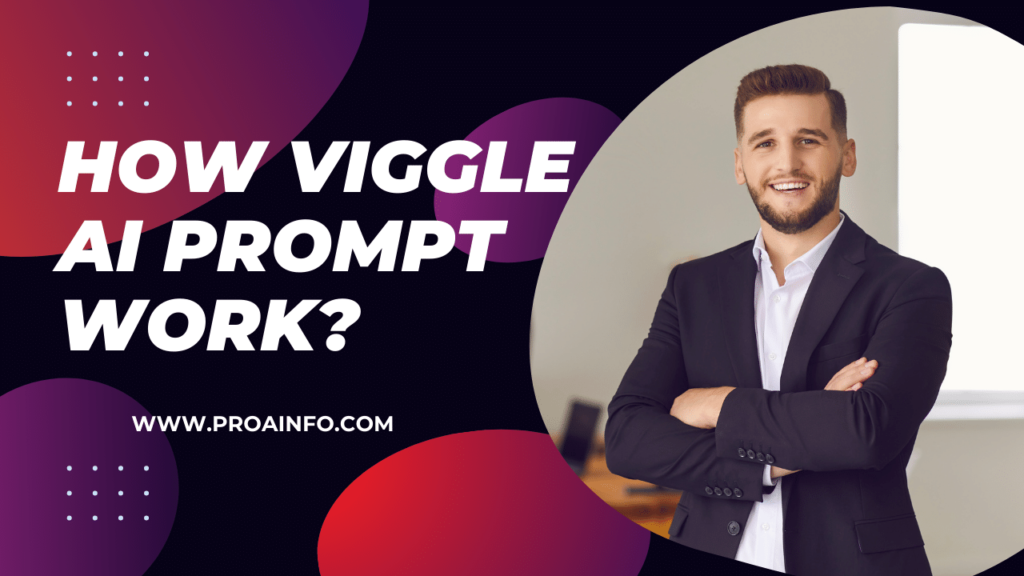How Viggle AI Prompt Work? Viggle AI is an innovative artificial intelligence (AI) technology that has been making waves in the world of digital content creation and manipulation. At its core, Viggle AI is designed to analyze the movement patterns within a video clip and then apply those patterns to a static image, effectively bringing the image to life.
The underlying principle behind Viggle AI is the concept of motion transfer. By studying the way objects, characters, or environments move within a video, the AI is able to extract valuable data about the dynamics of that movement. This information is then used to animate a static image, imbuing it with a sense of motion and lifelike qualities.
The Viggle AI Technology:
Viggle AI is powered by a complex and multifaceted technology that combines various techniques and algorithms to achieve its impressive results. Here’s a closer look at the key components that make Viggle AI work:
1. Computer Vision and Motion Analysis
At the heart of Viggle AI is a sophisticated computer vision system that is capable of analyzing the movement patterns within a video clip. This involves the use of advanced algorithms that can detect and track the motion of objects, characters, and environments in real-time.
The motion analysis component of Viggle AI is particularly crucial, as it allows the system to extract valuable data about the dynamics of the movement. This includes information about the speed, direction, and trajectory of the various elements within the video.
2. Deep Learning and Neural Networks
Viggle AI’s ability to apply the extracted motion data to a static image is made possible through the use of deep learning and neural networks. These advanced AI techniques enable the system to learn and understand the complex relationships between the movement patterns in the video and the visual characteristics of the target image.
By training its neural networks on vast datasets of video and image data, Viggle AI develops a deep understanding of how motion can be mapped onto static visuals. This allows the system to generate realistic and seamless animations that closely mimic the movement observed in the original video.
3. Real-Time Processing and Performance Optimization
One of the key features of Viggle AI is its ability to process video and image data in real-time, enabling users to see the results of the motion transfer almost instantly. This is achieved through the use of specialized hardware and software optimizations that allow the system to perform computationally intensive tasks with lightning-fast speed.
Additionally, Viggle AI has been designed with a focus on efficiency and performance, ensuring that the system can handle high-resolution media and deliver high-quality results without sacrificing speed or responsiveness.
Applications of Viggle AI:
The capabilities of Viggle AI have far-reaching applications across a wide range of industries and use cases. Here are some of the most prominent applications of this innovative technology:
1. Digital Content Creation and Manipulation
One of the primary applications of Viggle AI is in the realm of digital content creation and manipulation. By allowing users to infuse static images with the dynamic movement of video, Viggle AI opens up new possibilities for creating engaging and immersive visual content.
This can be particularly useful in fields such as video production, advertising, and social media, where the ability to add motion and animation to images can significantly enhance the overall impact and engagement of the content.
2. Augmented Reality and Virtual Reality
Viggle AI’s motion transfer capabilities also have significant implications for the development of augmented reality (AR) and virtual reality (VR) experiences. By integrating Viggle AI into AR and VR applications, developers can create more realistic and immersive environments where static elements can be brought to life through the application of video-derived motion.
This could be particularly useful in gaming, entertainment, and even industrial applications, where the ability to seamlessly blend real-world and virtual elements can greatly enhance the user experience.
3. Interactive Displays and Installations
Viggle AI’s real-time processing capabilities make it an ideal technology for the development of interactive displays and installations. By applying the motion transfer capabilities to large-scale or interactive screens, Viggle AI can transform static visual elements into dynamic, engaging experiences that captivate viewers.
This could be leveraged in settings such as museums, galleries, trade shows, and public spaces, where the ability to create visually striking and interactive displays can draw in audiences and enhance their overall experience.
4. Educational and Training Applications
The motion transfer capabilities of Viggle AI also have potential applications in the field of education and training. By using the technology to animate instructional materials, educational content creators can make complex concepts more engaging and easier to understand.
Additionally, Viggle AI could be used in the development of virtual simulations and training environments, where the ability to apply realistic motion to static elements can enhance the realism and immersion of the experience.
5. Accessibility and Inclusion
Viggle AI’s ability to bring static images to life can also have implications for accessibility and inclusion. By applying motion transfer to visual content, the technology can help individuals with certain cognitive or visual impairments better understand and engage with the information presented.
This could be particularly useful in the development of assistive technologies, where Viggle AI could be integrated to provide more dynamic and interactive experiences for users with diverse needs.
The Viggle AI Workflow:
The process of using Viggle AI to apply motion transfer to a static image involves a series of steps that leverage the technology’s advanced capabilities. Here’s a step-by-step breakdown of the typical Viggle AI workflow:
1. Video Capture and Selection
The first step in the Viggle AI workflow is to capture or select the appropriate video clip that will be used as the source of the motion data. This video should feature the type of movement and dynamics that the user wishes to apply to their static image.
The video can be captured using a variety of devices, such as cameras, smartphones, or even screen recordings, and should be of high enough quality to ensure that the motion analysis algorithms can effectively extract the necessary data.
2. Image Preparation
Before the motion transfer can be applied, the static image that will be the target of the animation must be prepared. This may involve tasks such as cropping, resizing, or adjusting the image to ensure that it is compatible with the Viggle AI system and the desired output.
Additionally, users may choose to perform some basic edits or enhancements to the image, such as adjusting the color, contrast, or lighting, to optimize the final result.
3. Motion Analysis and Data Extraction
With the video and image assets ready, the next step in the Viggle AI workflow is to analyze the video clip and extract the necessary motion data. This is where the computer vision and motion analysis components of the system come into play.
The Viggle AI algorithms will carefully study the movement patterns within the video, tracking the speed, direction, and trajectory of the various elements. This data is then processed and prepared for the next stage of the workflow.
4. Motion Transfer and Animation
Once the motion data has been extracted, Viggle AI can begin the process of transferring that movement to the static image. This is where the deep learning and neural network components of the system come into play.
The Viggle AI algorithms will use the extracted motion data to generate a realistic and seamless animation that is applied to the target image. This may involve techniques such as warping, morphing, and compositing to ensure that the motion is integrated smoothly and believably.
5. Output and Delivery
The final step in the Viggle AI workflow is the output and delivery of the animated image. Depending on the user’s needs, the animated image can be exported in a variety of formats, such as video, GIF, or even a series of still frames.
The output can then be shared, used, or integrated into a variety of digital content, such as websites, social media posts, presentations, or even interactive installations.
The Benefits of Viggle AI:
The use of Viggle AI technology offers a range of benefits for users and content creators across various industries. Here are some of the key advantages of incorporating Viggle AI into digital content creation and manipulation workflows:
1. Enhanced Engagement and Immersion
By adding motion and animation to static images, Viggle AI can significantly enhance the overall engagement and immersion of digital content. This can lead to increased viewer attention, higher levels of interactivity, and a more memorable user experience.
2. Streamlined Workflow and Efficiency
Viggle AI’s real-time processing and performance optimization capabilities can help to streamline the content creation workflow, reducing the time and effort required to bring static images to life. This can lead to increased productivity and faster turnaround times for projects.
3. Versatility and Adaptability
Viggle AI’s motion transfer capabilities can be applied to a wide range of image types and styles, making it a highly versatile tool for content creators. This flexibility allows users to experiment with different approaches and explore new creative possibilities.
4. Cost-Effectiveness
Compared to traditional animation or motion capture techniques, Viggle AI can be a more cost-effective solution for adding dynamic movement to visual content. This can be particularly beneficial for smaller-scale projects or organizations with limited budgets.
5. Accessibility and Inclusivity
As mentioned earlier, Viggle AI’s ability to make visual content more engaging and interactive can have positive implications for accessibility and inclusivity, particularly for individuals with certain cognitive or visual impairments.
6. Scalability and Customization
Viggle AI’s underlying technology is designed to be scalable and customizable, allowing it to be integrated into a wide range of digital platforms and applications. This makes it a versatile tool that can adapt to the evolving needs of users and industries.
The Future of Viggle AI:
As the field of artificial intelligence continues to advance, the potential of Viggle AI and similar motion transfer technologies is poised to grow exponentially. Here are some of the exciting developments and future directions that could shape the future of Viggle AI:
1. Advancements in Computer Vision and Deep Learning
As the underlying computer vision and deep learning algorithms that power Viggle AI continue to evolve, the system’s ability to accurately extract and apply motion data is likely to become increasingly sophisticated. This could lead to even more realistic and seamless animations, as well as the ability to handle more complex and nuanced movement patterns.
2. Expansion of Applications and Use Cases
As Viggle AI’s capabilities expand, the range of applications and use cases for the technology is likely to grow as well. This could include further developments in areas like AR/VR, interactive displays, and accessibility, as well as the exploration of new domains such as medical visualization, scientific modeling, and beyond.
3. Improved Real-Time Performance and Efficiency
Ongoing advancements in hardware and software optimization are expected to further enhance Viggle AI’s real-time processing capabilities, allowing for even faster and more efficient motion transfer. This could enable new use cases that require near-instantaneous results, such as live events, interactive installations, and real-time content creation.
4. Increased Personalization and Customization
As Viggle AI systems become more sophisticated, the potential for increased personalization and customization of the motion transfer process is also likely to emerge. This could include the ability to fine-tune the animation parameters, integrate user-specific preferences, or even leverage machine learning to create personalized motion profiles.
5. Seamless Integration with Other Digital Tools
The future of Viggle AI may also involve tighter integration with other digital tools and platforms, allowing users to seamlessly incorporate motion transfer capabilities into their existing workflows and applications. This could include integrations with video editing software, design suites, social media platforms, and more.
6. Ethical Considerations and Responsible Development
As Viggle AI and similar technologies continue to advance, it will be crucial for developers and researchers to consider the ethical implications of their work. This may involve addressing concerns around privacy, data usage, and the potential for misuse or unintended consequences. Responsible development and transparent communication will be key to ensuring that Viggle AI and other motion transfer technologies are deployed in a way that benefits society as a whole.
Conclusion
Viggle AI is a groundbreaking technology that has the potential to revolutionize the way we create, manipulate, and interact with digital content. By leveraging advanced computer vision, deep learning, and motion analysis techniques, Viggle AI enables the seamless transfer of movement from video to static images, breathing life into otherwise inanimate visuals.
From digital content creation and augmented reality to interactive displays and educational applications, the applications of Viggle AI are vast and ever-expanding. As the technology continues to evolve, we can expect to see even more innovative and engaging use cases that push the boundaries of what is possible in the digital realm.
As with any transformative technology, Viggle AI also raises important questions about ethics, privacy, and responsible development. It will be crucial for the creators and users of Viggle AI to navigate these considerations carefully, ensuring that the technology is deployed in a way that benefits society and respects the wellbeing of all.
Ultimately, Viggle AI represents a remarkable leap forward in the world of digital content creation and manipulation, offering content creators and users alike a powerful tool to bring their visions to life in new and compelling ways. As the technology continues to mature and evolve, the future of Viggle AI promises to be both exciting and transformative.








1 thought on “how viggle ai prompt work?”